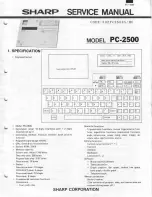
32
Overview of the Fantom-G
Broadly speaking, the Fantom-G consists of a
controller section
,
sound generator section
,
sequencer section
, and
sampler
section
.
fig.04-001.j
Controller section
This section includes the keyboard, pads, pitch bend / modulation
lever, the panel knobs, sliders, and D Beam controller, and pedals
connected to the rear panel.
Sound generator section
This section generates sound in response to performance data from
the controller section or sequencer section.
Sequencer section
This is a sequencer with 128 MIDI tracks and 24 audio tracks. The
MIDI tracks record performance data (MIDI) from the keyboard,
pads, and other controllers. The audio tracks record sound (audio)
from a mic or guitar connected to the Fantom-G’s audio input jacks.
Sampler section
A sampler is a device that captures (samples) sound from a CD
player or mic connected to the audio input or digital input, and
saves this sample as a wave file.
A captured sample can be used in the same way as the waveforms of
the sound generator section. You can also sample the sound of the
internal sound generator section itself (p. 258).
The Fantom-G can load WAV/AIFF format wave files from your
computer via USB as samples.
When using the Fantom-G, you’ll encounter various units of sound.
Here we’ll provide a simple explanation of these units.
Tone
A Tone is the smallest unit of sound in the Fantom-G. However, you
can’t play a tone by itself. The smallest unit of sound that you can
play is the “Patch,” so you can think of tones as the sonic material
that makes up each patch.
fig.04-002.j
A tone consists of the following five elements.
WG (Wave Generator)
This selects the PCM waveform (wave) that is the basis of the sound,
and specifies how its pitch will change.
All of the patches built into the Fantom-G consist of combinations of
tones that are based on PCM waveforms (waves).
A rhythm tone (percussion instrument sound) contains four wave generators.
TVF (Time Variant Filter)
This specifies how the frequency components of the sound will
change over time.
TVA (Time Variant Amplifier)
This specifies volume change and panning.
Envelope
An envelope specifies a change over time. Dedicated envelopes are
provided for Pitch, TVF (filter), and TVA (volume). For example, if
you want to modify the time over which the sound starts or decays,
you would use the TVA Envelope settings to specify the desired
time-variant volume change.
LFO (Low Frequency Oscillator)
An LFO creates cyclic change (modulation). There are two LFOs, and
each can be applied to one aspect of the sound; WG (pitch), TVF
(filter), or TVA (volume). Applying an LFO to the WG pitch will
produce vibrato, applying it to the TVF cutoff frequency will produce
wah, and applying it to the TVA volume will produce tremolo.
A rhythm tone (percussion instrument sound) does not have an LFO.
How the Fantom-G is Organized
Basic Structure
Controller section
(controllers such as the keyboard, pads, and pitch bend lever)
Sound generator
section
Recording
Playback
Sequencer section
128 MIDI tracks
24 audio tracks
Performance
Sampler section
Sampling
Recording
Audio input
Different Units of Sound
WG
Pitch
Envelope
TVF
TVF
Envelope
TVA
Envelope
TVA
LFO 1
LFO 2
Control signal
Tone
Audio signal
Fantom-G_r_e.book 32 ページ 2009年7月2日 木曜日 午後2時55分
















































